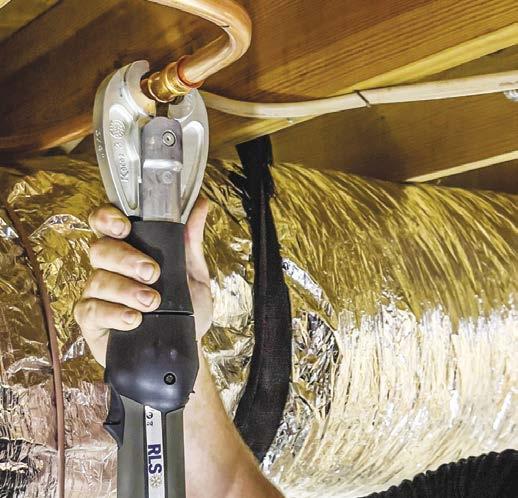
6 minute read
YOUR GAS IS AS GOOD AS MINE
Who would have thought that invisible and mostly odourless gases could cause such a stink?
A global debate around refrigerants has been raging for some time, and it is intensifying.
Advertisement
Australia is now five years into the official HFC phase down, a transition away from refrigerants that exacerbate global warming, towards more sustainable alternatives. Although there is often a gap between what the policy‑makers say and what happens at the “cold face”, you have probably noticed that some gases are now becoming less popular, especially refrigerants with a high global warming potential (GWP) such as R410A, R134a and R404A.
But while nearly everyone agrees that we must move away from the high GWP refrigerants, there is less agreement about which alternatives we should use.
It’s not as simple as choosing a gas with low GWP. Other properties need to be considered, from flammability to toxicity, from working pressure to temperature glide. You might reduce the impact of leaked refrigerant by choosing a low GWP option, but what if it comes at the cost of a less efficient system?
And because this is an area of rapid development, our knowledge is constantly evolving.
Lately, there has been mainstream news coverage of FPAS (per and polyfluoroalkyl substances), which are created when some of the new‑generation refrigerants break down in the atmosphere. Dubbed “forever chemicals”, FPAS persist in the environment and eventually, can find their way into humans. The concern is that these may be linked to health issues.

As I write this column, there are proposals in Europe to restrict PFAS, which would see bans on some of the refrigerants that were expected to replace HFCs. So where do we go from here?
Many are advocating for greater use of so called “natural” refrigerants. These include CO2, propane, and one very traditional refrigerant that is now being utilised in new ways: ammonia. Given that this is our refrigerant and refrigerants special issue, we decided to investigate the latest innovations with good ol’ R717. The feature starts on page 19.
I also encourage you to check out the article on page 24 about refrigerant GWP. Amid the weird and wonderful range of refrigerants on the market, it’s a great guide to the basic properties of all gases.
In the past our industry has shown a great capacity to adapt, to think outside the box, and find new solutions. It’s time for us to do it again.



1 Hey presto, new from Testo!
Testo has launched a range of new measuring instruments into the Australian market.
Testo says smooth and energy efficient operation of air conditioning and ventilation systems can only be ensured by regular measurements of the relevant parameters.
“With the new compact measuring instruments testo 417, testo 416 and testo 425, flow and volume flow measurement in ventilation ducts, at air inlets and outlets and when adjusting balanced residential ventilation is child’s play,” the firm says.
Testo notes that we spend almost 90 per cent of our time indoors every day. Indoor air quality and comfort are therefore essential for minimising health risks and ensuring performance in the workplace.
“Thanks to the new compact measuring instruments testo 535, testo 545 and testo 625, CO 2, illuminance, temperature and humidity are controlled quickly, easily and precisely, ensuring a healthy indoor climate that promotes performance,” says the firm.
“The new HVAC measuring instruments deliver precise results wherever you need them – fast, flexible, user friendly and connected to smartphones and tablets,” Testo says. “Whether installing and maintaining air conditioning and ventilation systems, servicing heating systems, ensuring indoor air quality and comfort, measuring pressure in industrial applications … the world market leader in measurement technology has the right measuring instrument for every relevant parameter.”
Go to testo.com.au ■
2 Dwyer’s bright idea
Dwyer Instruments has released a new carbon dioxide and temperature transmitter, the Series CDT S.

According to Dwyer, the transmitters accurately monitor the CO 2 concentration and temperature in indoor environments.

Built upon Dwyer’s standard carbon dioxide transmitter, the S option has a front facing LED that illuminates when the CO 2 level exceeds 1,100ppm.
Designed for schools and classrooms, the transmitters offer multiple sensing capabilities, simple installation with backplate electrical terminations, and a reduction in the number of installed devices by using integral temperature sensing. Go to www.dwyer inst.com.au ■
3 s-Mext comes next
Mitsubishi Electric Australia has launched a new cooling system for IT environments, s MEXT.

The split cooling package consists of the s MEXT high precision air conditioner indoor unit connected to a Mr Slim R32 inverter outdoor unit.
“The product is monumental for data centres around the country, where 40 per cent of total electricity usage comes from air conditioning,” says Mitsubishi Electric.
“Aside from its energy efficiency focus, the new s MEXT air conditioning has been designed with data centres front of mind, and is equipped to precisely control temperature and relative humidity.”
According to Mitsubishi Electric, the small size design means it can easily integrate into small IT rooms, small data centres, or distribution rooms.
Mitsubishi Electric Australia National Product Manager Atesh Mani says the new product is an important innovation for data centres around the country.
“We’re really excited to launch the latest product in the Mitsubishi Electric IT cooling family,” he says. “The s MEXT has really been manufactured to provide IT environments with powerful cooling solutions while providing businesses with a R32 refrigerant option.”
Mani says increased power densities in IT environments have led to growing temperatures (up to 23°C) of intake airflows directed to the IT equipment.
The s MEXT and Mr Slim cooling package was designed to manage return air temperatures up to 35°C, matching the requirements of the most critical data centres.
“We’re very aware that a significant portion of the electricity consumed by data centres is by air conditioning,” says Mani. “As such, it is really important that we are constantly innovating to meet the highest energy efficiency standards.”
S MEXT is available in over (top air supply) and under (bottom air supply) variants, for a wider range of applications.
Go to www.mitsubishielectric.com.au ■
4 Elitech launches in Oz
The Elitech brand is launching in Australia.
“Elitech Australia’s wide range of refrigerant leak detectors offers refrigeration technicians precision at the time of identifying gas leaks in air conditioning systems and coldrooms,” the company says.
“The ILD 200 is a handheld refrigerant leak detector with a 10 year long life infrared sensor in a low cost package that detects leaks of CFC, HFC, HCFC and HFO refrigerants. This is eight times longer than a thermal diode.
“The ILD 200 includes strong anti interference technology, which avoids false alarms from interfering gases. A large TFT colour screen provides an excellent visual display.
“It’s ready for use in 30 seconds, and has three selectable sensitivity levels and eight hours’ battery life in a single charge.” There are three models: ILD 100/200/300.
Elitech says that the ILD 200 and ILD 300 offer peak recording and automatic calibration, which helps pinpoint leak points quickly.
Go to www.elitechau.com ■
5
Daikin’s commercial refrigeration push
Daikin Australia has launched a strategic new refrigeration business unit following the introduction of a range of commercial refrigeration condensing units. The units are designed specifically for refrigeration applications to operate display cabinets and coolrooms for supermarkets, convenience stores, service stations, as well as food and beverage services.
“On a global level, Daikin has over 100 years of extensive experience in the commercial refrigeration market including unrivalled quality and innovation in refrigerants, controls and compressors,” says General Manager Applied and Solutions Guarav Malik, Affil.AIRAH.
“The new local refrigeration business unit allows Daikin Australia to capitalise on the company’s global expertise and provide a broader suite of integrated solutions, service and support to our commercial customers.”
The condensing units are manufactured by J&E Hall, a worldwide member of the Daikin Group. They are designed for small capacity refrigeration applications with a number of new features and functions. “The new compact condensing units offer efficient operation, improved reliability and longevity,” says Daikin. “Microchannel heat exchanger technology reduces refrigerant volume in the system in a more efficient way than traditional fin and tube heat exchangers, providing savings on installation costs. A new adjustable fan speed and pressure switch provides added flexibility to deliver optimal operation for the chosen refrigerant.”
According to Daikin, the units are extremely quiet and efficient during operation due to the acoustically lined casing and the option of low fan speeds, making them suitable for noise sensitive projects.

The range includes 27 medium temperature models ranging from 0.9–15.5kW capacity and 14 low temperature models ranging from 0.8–12.8kW capacity.


“Daikin is dedicated to strengthening its presence in the refrigeration segment by eventually providing solutions in all phases of the cold chain,” says the company. “Customers can expect to see the introduction of a wider line of refrigeration equipment for commercial and industrial use in the near future.”
Go to commercial.daikin.com.au ■
6 The TradeMutt drop
TradeMutt is a social impact workwear brand, by tradies for tradies.
The brand aims to make tradies and workers of all kinds look and feel great at work, and in doing so, reduce the rate of blue collar suicide in Australia.
“Our loud and vibrant shirts act as a catalyst to starting the conversation around mental health in men,” the company says. “It’s a topic that has been hard to approach in the past for blokes, mostly due to the attached stigmas and perceived weakness.”

The company regularly releases limited edition styles on a range of workwear clothes such as high viz vests, workshirts and the like.
The latest drop is a style dubbed “Wipeout”.
“At TradeMutt we have always been about making the invisible issue of mental health impossible to ignore with our colourful, conversation starting work and lifestyle wear,” the company says. “However, as the brand and in turn our community has grown, so has our responsibility to provide resources that help facilitate and nurture the conversations that we start.”
Go to trademutt.com/collections/wipeout ■









